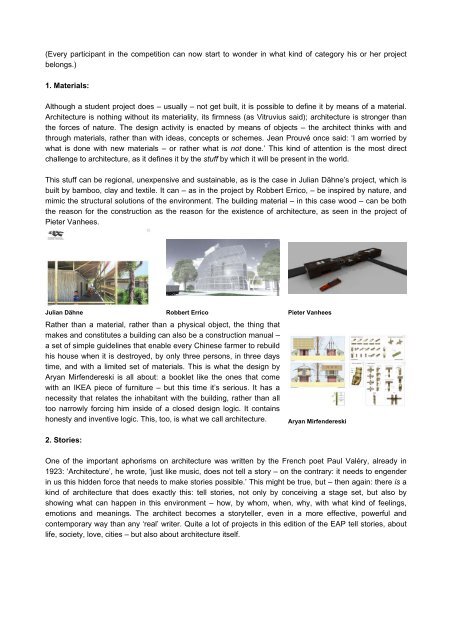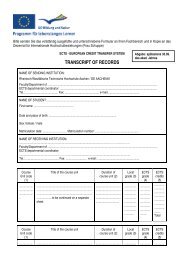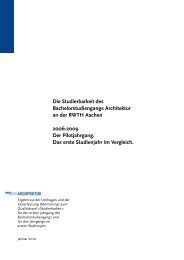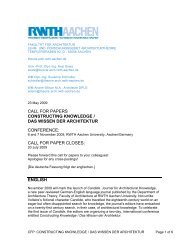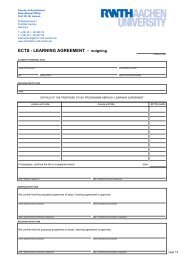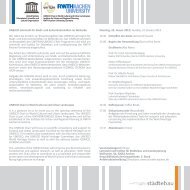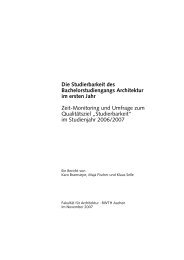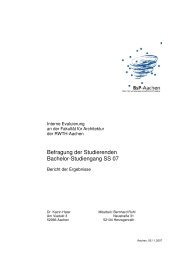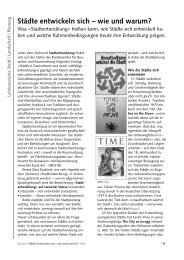Power and impotence Ladies and gentlemen, but of ... - RWTH Aachen
Power and impotence Ladies and gentlemen, but of ... - RWTH Aachen
Power and impotence Ladies and gentlemen, but of ... - RWTH Aachen
Create successful ePaper yourself
Turn your PDF publications into a flip-book with our unique Google optimized e-Paper software.
(Every participant in the competition can now start to wonder in what kind <strong>of</strong> category his or her project<br />
belongs.)<br />
1. Materials:<br />
Although a student project does – usually – not get built, it is possible to define it by means <strong>of</strong> a material.<br />
Architecture is nothing without its materiality, its firmness (as Vitruvius said); architecture is stronger than<br />
the forces <strong>of</strong> nature. The design activity is enacted by means <strong>of</strong> objects – the architect thinks with <strong>and</strong><br />
through materials, rather than with ideas, concepts or schemes. Jean Prouvé once said: ‘I am worried by<br />
what is done with new materials – or rather what is not done.’ This kind <strong>of</strong> attention is the most direct<br />
challenge to architecture, as it defines it by the stuff by which it will be present in the world.<br />
This stuff can be regional, unexpensive <strong>and</strong> sustainable, as is the case in Julian Dähne’s project, which is<br />
built by bamboo, clay <strong>and</strong> textile. It can – as in the project by Robbert Errico, – be inspired by nature, <strong>and</strong><br />
mimic the structural solutions <strong>of</strong> the environment. The building material – in this case wood – can be both<br />
the reason for the construction as the reason for the existence <strong>of</strong> architecture, as seen in the project <strong>of</strong><br />
Pieter Vanhees.<br />
Julian Dähne Robbert Errico Pieter Vanhees<br />
Rather than a material, rather than a physical object, the thing that<br />
makes <strong>and</strong> constitutes a building can also be a construction manual –<br />
a set <strong>of</strong> simple guidelines that enable every Chinese farmer to rebuild<br />
his house when it is destroyed, by only three persons, in three days<br />
time, <strong>and</strong> with a limited set <strong>of</strong> materials. This is what the design by<br />
Aryan Mirfendereski is all about: a booklet like the ones that come<br />
with an IKEA piece <strong>of</strong> furniture – <strong>but</strong> this time it’s serious. It has a<br />
necessity that relates the inhabitant with the building, rather than all<br />
too narrowly forcing him inside <strong>of</strong> a closed design logic. It contains<br />
honesty <strong>and</strong> inventive logic. This, too, is what we call architecture.<br />
2. Stories:<br />
Aryan Mirfendereski<br />
One <strong>of</strong> the important aphorisms on architecture was written by the French poet Paul Valéry, already in<br />
1923: ‘Architecture’, he wrote, ‘just like music, does not tell a story – on the contrary: it needs to engender<br />
in us this hidden force that needs to make stories possible.’ This might be true, <strong>but</strong> – then again: there is a<br />
kind <strong>of</strong> architecture that does exactly this: tell stories, not only by conceiving a stage set, <strong>but</strong> also by<br />
showing what can happen in this environment – how, by whom, when, why, with what kind <strong>of</strong> feelings,<br />
emotions <strong>and</strong> meanings. The architect becomes a storyteller, even in a more effective, powerful <strong>and</strong><br />
contemporary way than any ‘real’ writer. Quite a lot <strong>of</strong> projects in this edition <strong>of</strong> the EAP tell stories, about<br />
life, society, love, cities – <strong>but</strong> also about architecture itself.


